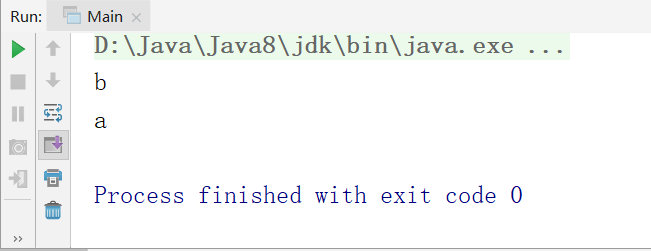顺序栈
/**
* 顺序栈
* */
public class SqStack {
//栈的大小
private int maxSize;
//栈顶指针
private int top;
private char[] stack;
public SqStack(int size){
maxSize = size;
top = -1;
stack = new char[maxSize];
}
//压栈
public void push(char value){
stack[++top] = value;
}
//出栈
public char pop(){
return stack[top--];
}
//返回栈顶指针
public char peek(){
return stack[top];
}
//栈是否满
public boolean idFull(){
return maxSize-1==top;
}
//栈是否为空
public boolean isEmpty(){
return top==-1;
}
}
测试
SqStack sqStack = new SqStack(10);
sqStack.push('a');
sqStack.push('b');
System.out.println(sqStack.pop());
System.out.println(sqStack.pop());
输出

链栈
import sun.awt.image.ImageWatched;
/**
* 链栈
* */
public class LinkStack {
/**
* @param size 栈的大小
* @param top 栈顶指针
* */
private int size;
private Node top =null;
class Node{
int data;
Node next = null;
public Node(int data){
this.data = data;
}
}
/**
* 压栈
* @param data 节点数据
* */
public void push(int data){
Node node = new Node(data);
node.next = top;
top = node;
size++;
}
/**
* 出栈
* */
public int pop()throws Exception{
if(top==null)
throw new Exception("空的");
else {
int data = top.data;
top = top.next;
size--;
return data;
}
}
public int getSize(){
return size;
}
public boolean isEmpty(){
return size==0;
}
public void showAllNode() throws Exception{
if(top==null)
throw new Exception("空栈");
else {
Node node = top;
while (node!=null){
System.out.println(node.data);
node = node.next;
}
}
}
}
测试
LinkStack stack = new LinkStack();
stack.push(2);
stack.push(3);
stack.showAllNode();
结果

队列
点类
public class Node<T> {
//存储的数据
private T data;
//下一个节点
private Node<T> next;
public Node(T data){
this.data = data;
}
public T getData() {
return data;
}
public void setData(T data) {
this.data = data;
}
public Node<T> getNext() {
return next;
}
public void setNext(Node<T> next) {
this.next = next;
}
}
队列类
public class LinkQuene {
//头
private Node<Integer> front;
//尾
private Node<Integer> rear;
//大小
private int size;
/**
* 创建队列
* */
public LinkQuene(){
front = rear = null;
}
/**
* 入列
* @param data 节点数据
* */
public void enter(Integer data){
Node<Integer> node = new Node<>(data);
if(isEmpty()){
front = rear = node;
}else{
rear.setNext(node);
rear = node;
}
size++;
}
/**
* 出列
* */
public Integer out(){
Node node = new Node(-1);
if(isEmpty()){
System.out.println("队列是空的");
return (Integer) node.getData();
}else {
node = front;
front = node.getNext();
node.setNext(null);
size--;
}
if(size==0){
front = null;
rear = null;
}
return (Integer) node.getData();
}
/**
* 判断是否为空
* */
public boolean isEmpty(){
return front==null&&rear==null?true:false;
}
/**
* 得到个数
* */
public int getSize(){
return this.size;
}
}
测试:
LinkQuene quene = new LinkQuene();
quene.enter(1);
quene.enter(2);
System.out.println(quene.getSize());
System.out.println(quene.out());
System.out.println(quene.getSize());
结果
